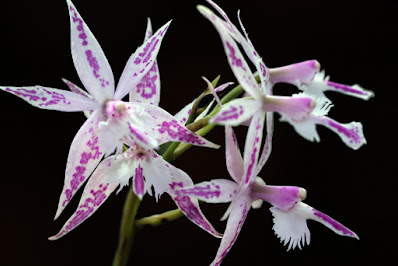Barkeria orchid flowers are often long-lasting, odorless to strongly fragrant, pale to vivid pink, lilac, deep purple or even white...
Barkeria orchid also called as Dothilophis is a genus in the Orchidaceae family. This genus was described by George Beauchamp Knowles and Frederic Westcott in 1838.
DESCRIPTION OF BARKERIA ORCHID
Barkeria orchid is native to Mexico to Central America. It is found growing in seasonally (notoriously) dry, low to upper elevation, hill scrub and montane oak–pine forests in Costa Rica, El Salvador, Guatemala, Honduras, Mexico Central, Mexico Gulf, Mexico Northwest, Mexico Southeast, Mexico Southwest, Nicaragua, Panamá.
The species of the genus are small to medium sized, warm to cool growing epiphytes or lithophyte with slender, spindle-shaped to cane-like pseudobulbs that are subtended by tight sheaths. The often-suffused red–purple or speckled purple leaves are spaced along the stem or clustered toward the tip of the stem. These are deciduous orchids, which drop their leaves in early winter.
The plants blooms from the pyramidal or cylindrical, few-flowered inflorescence with often long-lasting, odorless to strongly fragrant, pale to vivid pink, lilac, deep purple or even white flowers. The petals are similar to the sepals or broader, usually spreading, narrow to widely ovate, subclawed or not. The large, kite-like, shortly clawed, simple lip variously marked bright yellow, white, purple or magenta and has red lines radiating out from the short or long, straight to arched, widely winged, footless column. The broad lip, united to the column base, usually has a wavy, incurved or upturned margin with a blotch of bright color at the tip and a basal keeled callus. The whole flower can be variously spotted with lilac or black specs. The four pollinia, in two equally sized pairs, are waxy, laterally compressed, with granular caudicles.
BARKERIA ORCHID CARE
Cultural information should only be used as a guide, and should be to be adapted to suit you. Your physical location; where you grow your plants, how much time you have to devote to their care, and many other factors, will need to be taken into account. Only then can you decide on the cultural methods that best suit you and your plants.
Light:
Barkeria orchid needs a light level of 25000-40000 lux. A high level of light is required, but it should be dispersed or filtered. Probably, the plants will be in better condition if they are not exposed to the direct action of the southern sun. Strong air movement must be ensured all the time, especially if grown at high levels of light. If you have a cool humidifier, these plants will feel well placed near the outlet of cool, humid air.
Temperature:
These plant grow well under cool to intermediate conditions. The average temperature of the summer day is 24-27 ° C, the night 14-17 ° C, and the daily difference is 8-12 ° C. The average temperature of the winter day is 23-24 ° C, the night 12-15 ° C, and the daily difference is 9-11 ° C.
Humidity:
Barkeria orchid needs the average humidity of 70-80%. Too dry air has a negative effect on the development of the plant: its growth is inhibited, and the leaves begin to turn yellow and dry out. The higher temperature, the higher the humidity should be, and the higher the humidity, the more often and longer it is necessary to ventilate the room where the plants are contained, otherwise the probability of rotting and various kinds of fungal diseases. Good air movement is essential while the plants are in leaf and growing.
Substrate, growing media and repotting:
Barkeria orchid are best grown on cork or tree fern rootstock, if it is possible to provide high humidity and watering in summer at least once a day. During hot, dry weather, it may be necessary to water several times a day.
The plants also grow very well mounted on the branches, run horizontally, in quite shady places. If you can not mount the plants, you can grow them in small, shallow pots or baskets with a very airy substrate. Although potted plants are not growing well, some plants of the Barkeria genus are able to adapt to growing in baskets, if we use a small amount of very thick substrate, such as pieces of tree fern.
Watering:
These plants should be abundantly watered during active growth, at least once a day if the weather is hot and the level of light is high, but their roots must dry quickly. When new growths reach maturity in autumn, the amount of water should be reduced.
Fertilizer:
In the period of active growth, a balanced fertilizer should be used, in 1/4-1/2 doses of fertilizer for orchids. You can also use phosphate-enriched fertilizer from mid-summer to the end of autumn to improve flowering in the next season and strengthen new growth before winter.
Rest period:
Barkeria orchid need a rest period when the leaves becoming deciduous. In winter and early spring, the plants should be considerably limited to the amount of water, but they can not remain completely dry for too long. Occasional morning misting, especially in sunny weather, will provide the plants with enough moisture and prevent excessive drying. Fertilization should be eliminated until new growths appear in the spring and normal watering begins.















COMMENTS